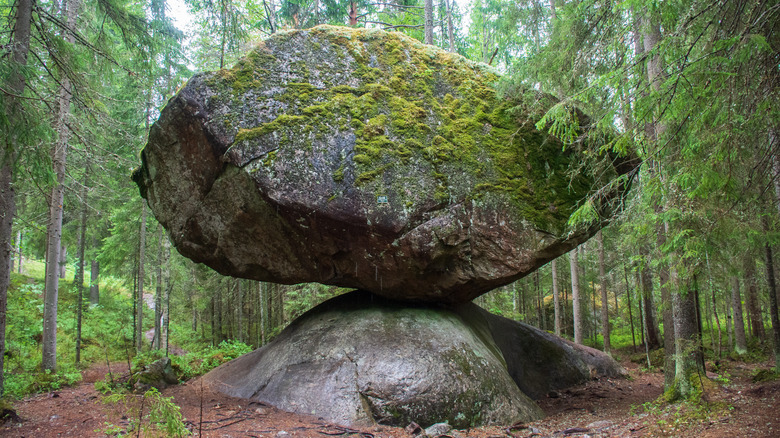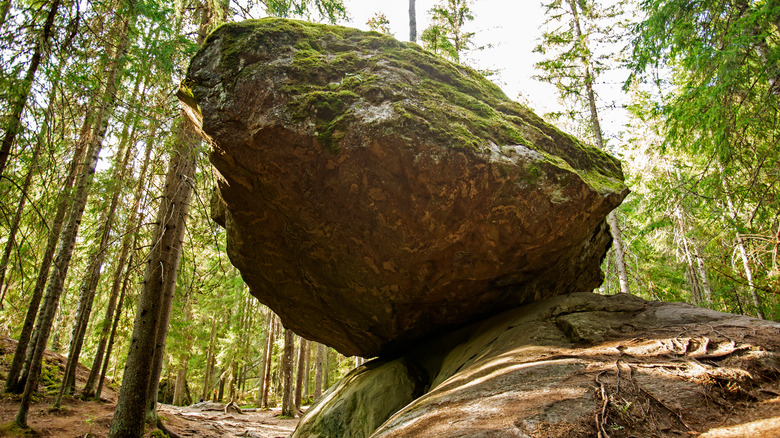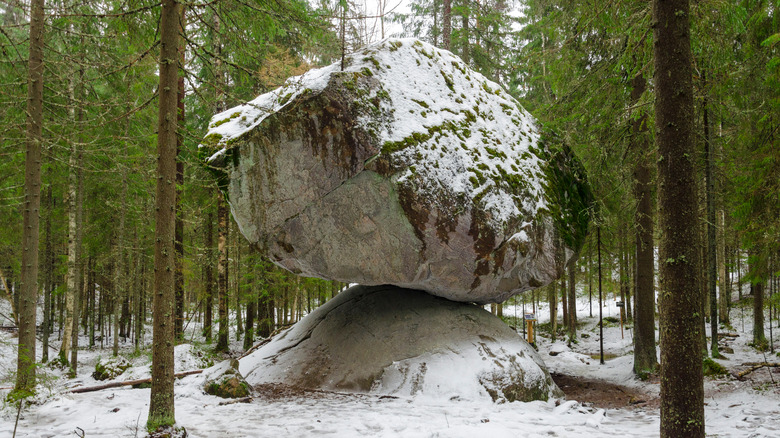Finland's Kummakivi Balancing Rock Seemingly Defies All The Rules Of Physics
Often, when someone says something is "impossible," they really just mean extremely unlikely or extremely difficult. Or, "impossible" is used to express surprise: "What do you mean Jim the pilot has been replaced with an orangutan, and he's even wearing Jim's hat while drinking a mango daiquiri? That's impossible!" But how many things do we come across that are actually impossible? The answer is "none," because impossible means just that: "not possible." You're welcome for the logic lesson.
That being said, one of the easiest things to marvel at is nature itself. A waterfall uncannily shaped like a bride wearing a wedding dress and veil near Cajamarca, Peru (via My Modern Met). The Al Naslaa rock formation in Saudi Arabia split in half by a perfectly clean, razor-straight line and balancing on two opposing rock pegs (per Big Think). There are plenty of geological formations like this around the world that defy easy explanation and lend themselves well to the "it was aliens" breed of speculation seen on shows like the History Channel's "Ancient Aliens." This is why the Ancient Greeks, for instance (via Greeka), were like: "See that big fireball in the sky? The god Phaethon is pulling it from east to west every day in his chariot."
Every now and then, though, certain phenomena appear truly puzzling. Take Kummakivi in Finland, a big rock precariously balanced on another rock, looking like it should have slid to the ground centuries long ago.
Tourist spot built by forest giants?
At first glance, Kummakivi — "strange rock" in Finnish — might leave visitors tilting their head and squinting to find the hidden wires. And to be sure, Kummakivi does get visitors, pilgrims, and the like. Sites like The Nomad Today outline how to reach what it calls "the mother of all Finnish stones" in Ruokolahti in the region of Karelia in Finland's southeast, somewhat close to the Russian border. It's located precisely at N=6818585.328, E=576101.029, and even with help from Google, it might be a good idea to have a backup map. Kummakivi is certainly off the beaten path, even though it's located at the end of its own narrow path that connects to a car park for tourists. The rock has been protected by the Finnish government since 1962.
Just like our aforementioned "the sun is pulled by a sky chariot" tale, there are lots of legends and folklore about Kummakivi. Finnish myth, the kind laid out in the Finnish national epic "Kalevala," is rich with tales of forest creatures, giants, wizards, trolls, etc. And as Kalevalaseura discusses, "Kalevala" was largely based on oral tales from Kummakivi's region, Karelia. Ancient Origins sketches out a general story about Finnish giants called "hiidet" — "hiisi" in the singular — who chuck around boulders and make gouges in rocks to use to churn milk. On the scientific side, it's most likely that Kummakivi was formed about 12,000 years ago during the last age by migrating glaciers.
A high density of magic rocks
So what accounts for Kummakivi's seemingly physics-defying balancing act? The answer is more common sense than you might realize. The fact is: heavy things don't automatically slide or fall more easily than light things. A piano on a San Franciscan incline? That's probably going bye-bye. But a coarsely textured, surface-gripping object? We've got strong friction to contend with. The interior of rocks isn't necessarily uniform in composition, either. Meaning, the density of Kummakivi isn't necessarily evenly distributed throughout, as the Wisconsin Geological and Natural History Survey explains. Rocky interiors are porous and have veins or pockets of lower density and empty space side-by-side clusters of minerals. In other words, the center of balance for a stone isn't always easily predictable.
Kummakivi also isn't the only rock of its type. Worldwide, there's an entire sub-category of selfsame geological phenomena dubbed "balance rocks," as Scienceinfo.net depicts. We've got the dramatically-named Druid's Idol in North Yorkshire, England, which is even more precisely balanced than Kummakivi. There's also Krishna's Butterball in Tamil Nadu, India (named after the eighth incarnation of the Hindu god Vishnu), Arches Rock in Arches National Park in Utah, and many more. In each case, a rocky formation takes on magical, mystical, and even religious significance.
Of course, each stone was formed by unique, perfectly explainable geological conditions. But that doesn't mean that those conditions weren't rare enough to make their creations seem "impossible." Maybe that's precisely how the natural world grants wonder and magic.


